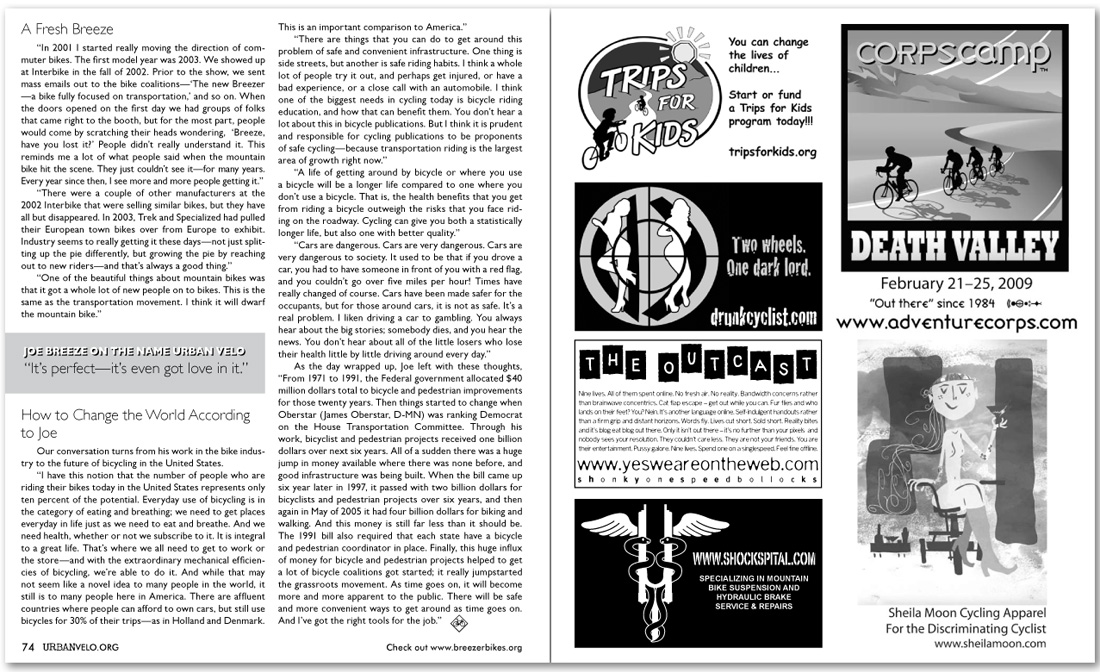

|
|||
Joe Breeze (continued)A Fresh Breeze “In 2001 I started really moving the direction of commuter bikes. The first model year was 2003. We showed up at Interbike in the fall of 2002. Prior to the show, we sent mass emails out to the bike coalitions—‘The new Breezer —a bike fully focused on transportation,’ and so on. When the doors opened on the first day we had groups of folks that came right to the booth, but for the most part, people would come by scratching their heads wondering, ‘Breeze, have you lost it?’ People didn’t really understand it. This reminds me a lot of what people said when the mountain bike hit the scene. They just couldn’t see it—for many years. Every year since then, I see more and more people getting it.” “There were a couple of other manufacturers at the 2002 Interbike that were selling similar bikes, but they have all but disappeared. In 2003, Trek and Specialized had pulled their European town bikes over from Europe to exhibit. Industry seems to really getting it these days—not just splitting up the pie differently, but growing the pie by reaching out to new riders—and that’s always a good thing.” “One of the beautiful things about mountain bikes was that it got a whole lot of new people on to bikes. This is the same as the transportation movement. I think it will dwarf the mountain bike.” How to Change the World According to Joe Our conversation turns from his work in the bike industry to the future of bicycling in the United States. “I have this notion that the number of people who are riding their bikes today in the United States represents only ten percent of the potential. Everyday use of bicycling is in the category of eating and breathing; we need to get places everyday in life just as we need to eat and breathe. And we need health, whether or not we subscribe to it. It is integral to a great life. That’s where we all need to get to work or the store—and with the extraordinary mechanical efficiencies of bicycling, we’re able to do it. And while that may not seem like a novel idea to many people in the world, it still is to many people here in America. There are affluent countries where people can afford to own cars, but still use bicycles for 30% of their trips—as in Holland and Denmark. This is an important comparison to America.” “There are things that you can do to get around this problem of safe and convenient infrastructure. One thing is side streets, but another is safe riding habits. I think a whole lot of people try it out, and perhaps get injured, or have a bad experience, or a close call with an automobile. I think one of the biggest needs in cycling today is bicycle riding education, and how that can benefit them. You don’t hear a lot about this in bicycle publications. But I think it is prudent and responsible for cycling publications to be proponents of safe cycling—because transportation riding is the largest area of growth right now.” “A life of getting around by bicycle or where you use a bicycle will be a longer life compared to one where you don’t use a bicycle. That is, the health benefits that you get from riding a bicycle outweigh the risks that you face riding on the roadway. Cycling can give you both a statistically longer life, but also one with better quality.” “Cars are dangerous. Cars are very dangerous. Cars are very dangerous to society. It used to be that if you drove a car, you had to have someone in front of you with a red flag, and you couldn’t go over five miles per hour! Times have really changed of course. Cars have been made safer for the occupants, but for those around cars, it is not as safe. It’s a real problem. I liken driving a car to gambling. You always hear about the big stories; somebody dies, and you hear the news. You don’t hear about all of the little losers who lose their health little by little driving around every day.” As the day wrapped up, Joe left with these thoughts, “From 1971 to 1991, the Federal government allocated $40 million dollars total to bicycle and pedestrian improvements for those twenty years. Then things started to change when Oberstar (James Oberstar, D-MN) was ranking Democrat on the House Transportation Committee. Through his work, bicyclist and pedestrian projects received one billion dollars over next six years. All of a sudden there was a huge jump in money available where there was none before, and good infrastructure was being built. When the bill came up six year later in 1997, it passed with two billion dollars for bicyclists and pedestrian projects over six years, and then again in May of 2005 it had four billion dollars for biking and walking. And this money is still far less than it should be. The 1991 bill also required that each state have a bicycle and pedestrian coordinator in place. Finally, this huge influx of money for bicycle and pedestrian projects helped to get a lot of bicycle coalitions got started; it really jumpstarted the grassroots movement. As time goes on, it will become more and more apparent to the public. There will be safe and more convenient ways to get around as time goes on. And I’ve got the right tools for the job.” Check out www.breezerbikes.com |
Joe Breeze on the name Urban Velo "It's perfect—it's even got love in it." |
|
|